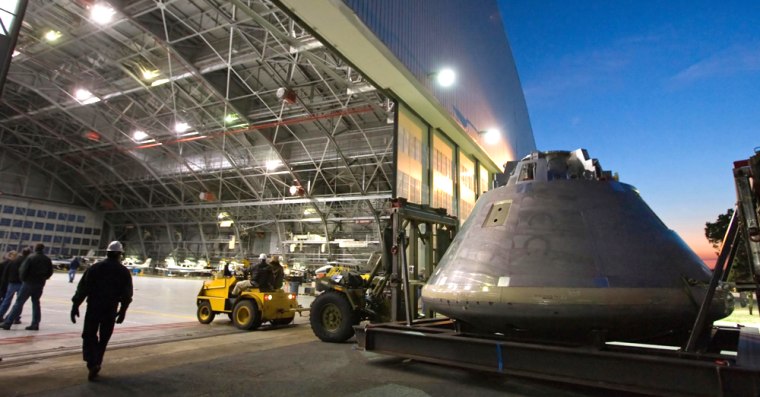The aluminum and steel cone-shaped object with a pair of white fuzzy dice hanging from an interior beam is the same size and shape of a spacecraft being designed to take astronauts to the international space station and then to the moon. But this mock-up of the Orion crew vehicle is headed for the New Mexico desert.
NASA's Langley Research Center on Wednesday showed off the simulated capsule, which will be used in the first in a series of tests of the ability of Orion's launch-abort system to whisk the astronauts and capsule to safety in case of a problem on the launch pad, such as a fire, or during the climb to orbit.
The test will be conducted in December, without anyone inside the simulated capsule, at the U.S. Army's White Sands Missile Range in New Mexico.
Langley is not building the Orion itself, but Langley engineers spent 10 months building the structure to represent the size, shape and mass of the space capsule, at a cost of about $3 million, said Phillip Brown, flight test article project manager at Langley.
"This is our first big baby that's going out the door," Brown said. "We're so excited."
The simulated capsule is 16.5 feet wide, nearly 13 feet tall and will weigh about 18,000 pounds when loaded with equipment.
On March 28, a C-17 military plane will fly the mock capsule to NASA's Dryden Flight Research Center in Edwards, Calif., to be outfitted with flight computers and other electronics.
Dryden then will send the completed module to White Sands.
During the test, the escape system's main abort motor will fire for a few seconds, lifting the module from a launch pad to an altitude of about 1 mile. Three parachutes, each 116 feet in diameter, will deploy to slow the module for landing.
The mock-up will not be reused after the first test; NASA Langley will be making two more versions of the simulated capsule for use in later tests.
"This is Orion Serial No. 1," Jay Estes, deputy of the Orion Flight Test Office at NASA's Johnson Space Center in Houston, said as he stood next to the mock capsule in a hangar at NASA Langley. "If we're half as successful as we expect to be out there, it will probably be in some museum somewhere."
Orion is intended to replace the space shuttle fleet, which is to be retired in 2010. The first launch for Orion is planned around 2014.
Orion is part of the Constellation Program to send people back to the moon and then to Mars. Orion will carry up to six astronauts to the international space station and up to four crew members, plus additional equipment, to the moon.
